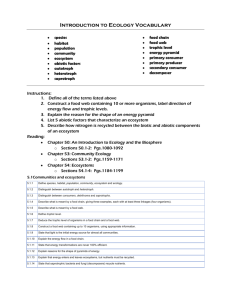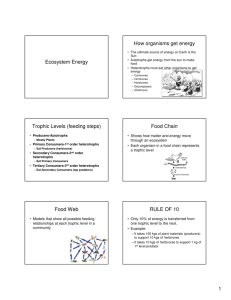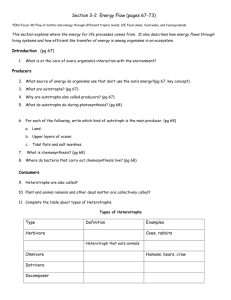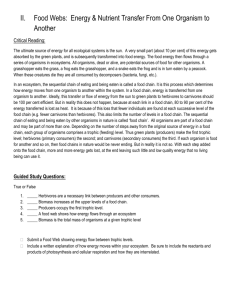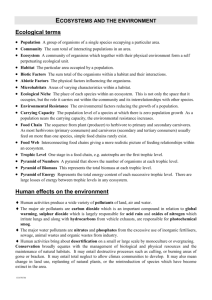CH. 16: The Fragile Earth
advertisement
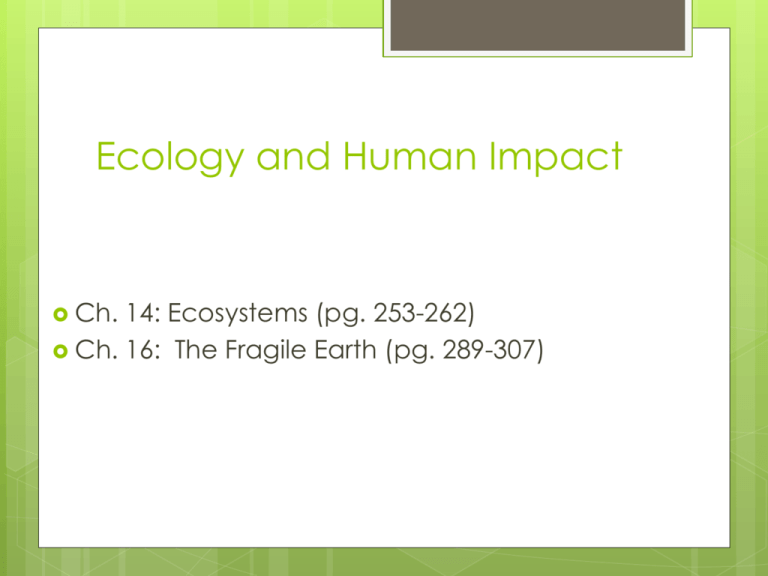
Ecology and Human Impact Ch. 14: Ecosystems (pg. 253-262) Ch. 16: The Fragile Earth (pg. 289-307) What is Ecology? Ecology – the study of the interactions of organisms with one another and with their physical environment. Biotic Factors – Organisms that are living (or WERE living at one time….paper, steak) ex) animals, plants, bacteria, fungus Abiotic Factors – Physical Environment (non-living) ex) water, air, dirt, rocks Ch. 14: Ecosystems What is an Ecosystem? A self-sustaining collection of organisms and their physical environment. ex) forest, river, lake. Food Webs and Energy Transfer Organisms obtain the energy they need to live by eating or taking in other sources of energy. If the flow of energy is disrupted, it can have disastrous results on the entire ecosystem What is the first source of energy for the planet? Important Terms Producer/Autotroph (Auto = self, troph = feeder) organisms that produce their own food directly from the sun’s energy. Take in energy from their surroundings and and store it in complex molecules such as carbohydrates. Use the process of photosynthesis to make complex molecules Consumers/Heterotrophs (hetero = other) Organisms that obtain energy by consuming other organisms. Feed on producers & other consumers Can be: herbivores carnivores omnivores Decomposers **Be able to define These terms from your Chapter 14 Vocabulary homework Important Terms Primary Consumer – Feeds on plants. All are herbivores. Secondary Consumer – Feeds on primary consumers. May be omnivore or carnivore Tertiary Consumer – Feeds on secondary consumer. May be omnivore or carnivore Quaternary Consumer – Feeds on tertiary consumer. May be omnivore or carnivore. Food Chain vs. Food Web Food Chain Food chain is one series of energy transfers in an ecosystem Food Web Food web is the interconnected food chains in an ecosystem Food Chain or Food Web? Important Terms Trophic Level – group of organisms who's energy source (the sun) is the same number of steps away from the sun. Energy flows from producer consumer. Producers are always the 1st trophic level Heterotrophs (consumers) are always at least the 2nd trophic level Trophic levels are different than consumer levels Level 5 Level 4 Level 3 Level 2 Level 1 Ecological Pyramids: graphs which illustrate the trophic levels in a community. Most ecological pyramids are large at the base and narrow at the top. This is because every time that an organism is eaten by the next trophic level, some of the energy is lost as heat. Less Energy More Energy Pyramid of Energy: Shows the energy available at each trophic level. The size of the blocks represents the proportion of energy Measured in Joules or Calories Pyramid of Numbers: Illustration each level of the number of organisms at


